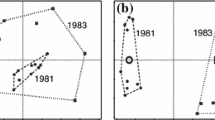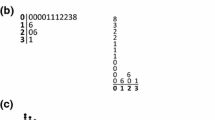Summary
A set of forty stands from an alpine fell-field in the Washington Cascades was used to test these ordination methods: polar ordination, principal components analysis, reciprocal averaging, and multidimensional scalings. Because no object ‘true’ ordination can be known for such data, a series of evaluative methods were employed to characterize each method. These criteria included the rank correlation to a direct ordination based on habitat data, the degree of distortion, skewness, and disjunction revealed, the ability to separate stands, the efficiency of species ordinations, ease of interpretation, objectivity, and how well the method recovers a classification of the same data.
Based on these criteria, reciprocal averaging performs best, with principal components analysis and multidimensional scaling not much worse. Most polar ordinations produce significant disjunctions and fail to separate stands well in one or more dimensions. Both of these properties result from the selection of partially disjunct stands as end points. These conclusions apply only to data with low beta diversity.
Similar content being viewed by others
References
Austin, M.P. 1968. An ordination study of a chalk grassland community. J. Ecol. 56: 739–758.
Austin, M.P. 1976. Performance of four ordination techniques assuming three different non-linear species response models. Vegetatio 33: 43–49.
Austin, M.P. & I., Noy-Meir. 1971. The problem of non-linearity in ordination: experiments with two-gradient models. J. Ecol. 59: 763–773.
Cottam, G., F.G., Goff & R.H., Whittaker. 1978. Wisconsin comparative ordination. In R.H., Whittaker (ed.), Ordination of plant communities, p. 185–215. Junk, The Hague.
Clifford, H.T. & W., Stephenson, 1975. Introduction to numerical classification. Academic Press, New York, 229 pp.
Fasham, M.J.R. 1977. A comparison of nonmetric and multidimensional scaling: principal components and reciprocal averaging for the ordination of simulated coenoclines. Ecology 58: 551–561.
Gauch, H.B.Jr. 1973. A quantitative evaluation of the Bray-Curtis ordination. Ecology 54: 829–836.
Gauch, H.B.Jr. 1977. ORDIFLEX. Ecology and Systematics, Cornell University, Ithaca, New York, 123 pp.
Gauch, H.B.Jr. & T.R., Wentworth, 1976. Canonical correlation analysis as an ordination technique. Vegetatio 33: 17–22.
Gauch, H.B.Jr. & R.H., Whittaker, 1972: Comparison of ordination techniques. Ecology 53: 868–875.
Gauch, H.B.Jr., R.H., Whittaker & T.R., Wentworth. 1977. A comparative study of reciprocal averaging and other ordination techniques. J. Ecol. 65: 157–174.
Goldstein, B.A. & D.F. Grigal. 1972. Computer programs for the ordination and classification of ecosystems. Oak Ridge Natl. Lab. ORNL-IBP-71-10.
Hitchcock, C.L. & A., Cronquist. 1973. Flora of the Pacific Northwest. Univ. Washington Press. Seattle. 730 pp.
Hill, M.O. 1973. Reciprocal averaging: an eigenvector method of ordination. J. Ecol. 61: 237–249.
Kessell, S.R. & R.H., Whittaker. 1976. Comparison of three ordination techniques. Vegetatio 32: 21–29.
Kruscal, J.B. 1964. Multidimensional scaling by optimizing goodness of fit to a nonmetric hypothesis. Psychometrika 20: 1–27.
Maarel, E.van der. 1979. Multivariate methods in phytosociology, with reference to the Netherlands. In: M.J.A., Werger (ed.). The study of vegetation. p. 161–227. Junk, The Hague.
Moral, R.del. 1974. Species patterns in the Upper North Fork Teanaway River drainage, Wenatchee Mountains, Washington. Syecis 7: 13–30.
Moral, R.del. 1979. High elevation vegegation of the Enchantment Lakes basin, Washington. Canad J. Bot. 57: 1111–1130.
Moral, R.del & A.F., Watson. 1978. Gradient structure of forest vegetation in the central Washington Cascades. Vegetatio 38: 29–48.
Noy-Meir, I. 1974. Catenation: quantitative methods for definition of coenoclines. Vegetatio 29: 89–99.
Noy-Meir, I. & R.H., Whittaker, 1977. Continuous multivariate methods in community analysis: some problems and developments. Vegetatio 33: 79–98.
Noy-Meir, I. & R.H., Whittaker. 1978. Recent developments in continuous multivariate techniques. In: R.H., Whittaker (ed.), Ordination of plant communities, p. 337–379. Junk, The Hague.
Peet, R. 1978. Forest vegetation of the Colorado Front Range: patterns of species diversity. Vegetatio 37: 65–78.
Robertson, P.A. 1978. Comparison of techniques for ordinating and classifying old-growth floodplain forests in southern Illinois. Vegetatio 37: 43–51.
Whittaker, R.H. 1960. Vegetation of the Siskiyou Mountains. Oregon and Washington. Ecol. Monogr. 30: 279–338.
Whittaker, R.H. & H.B., GauchJr. 1978. Evaluation of ordination techniques. In R.H., Whittaker (ed.). Ordination of plant communities. p. 277–337. Junk, The Hague.
Author information
Authors and Affiliations
Additional information
Nomenclature follows that of Hitchcock & Cronquist (1973)
Funds provided by the University of Washington Graduate School. Field assistance was provided by J.E. Canfield, M.J. Cushman, and A.F. Watson> L.C. Anderson provided helpful comments on the manuscript.
Rights and permissions
About this article
Cite this article
Del Moral, R. On selecting indirect ordination methods. Vegetatio 42, 75–84 (1980). https://doi.org/10.1007/BF00048873
Accepted:
Issue Date:
DOI: https://doi.org/10.1007/BF00048873




